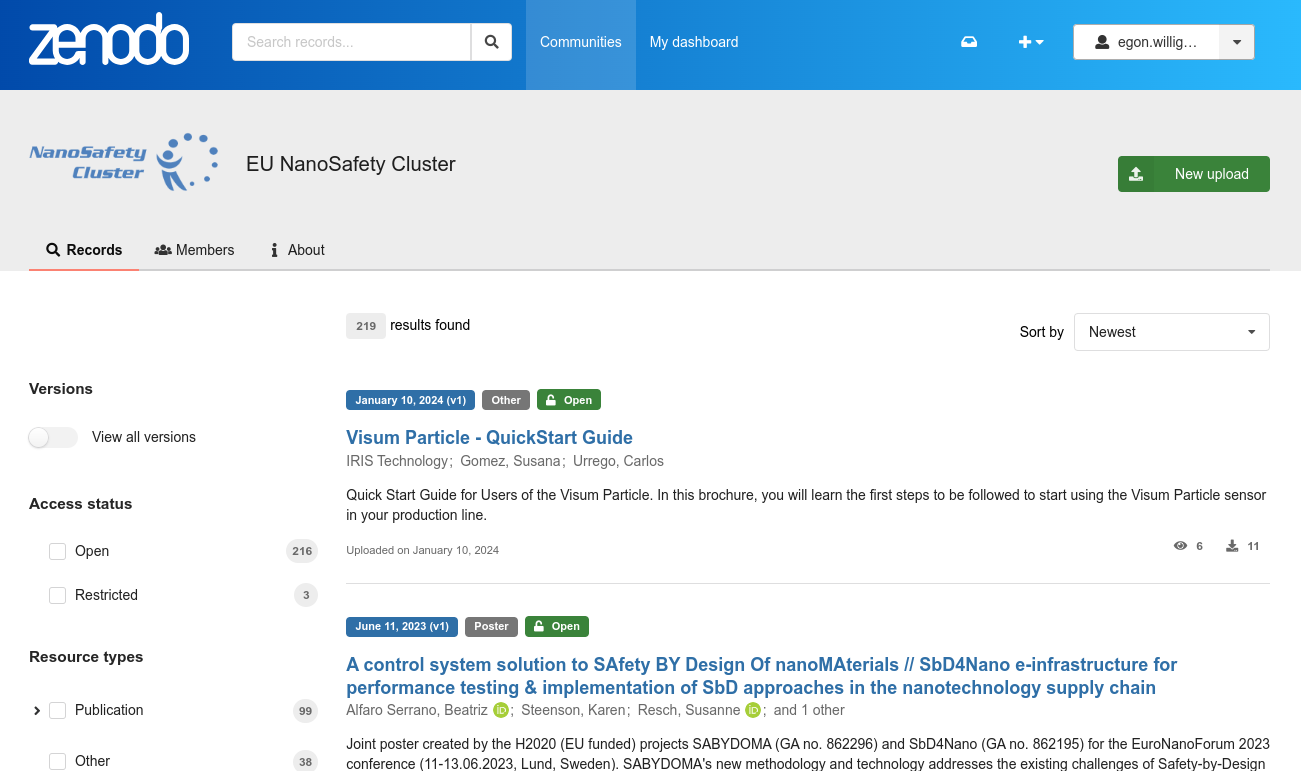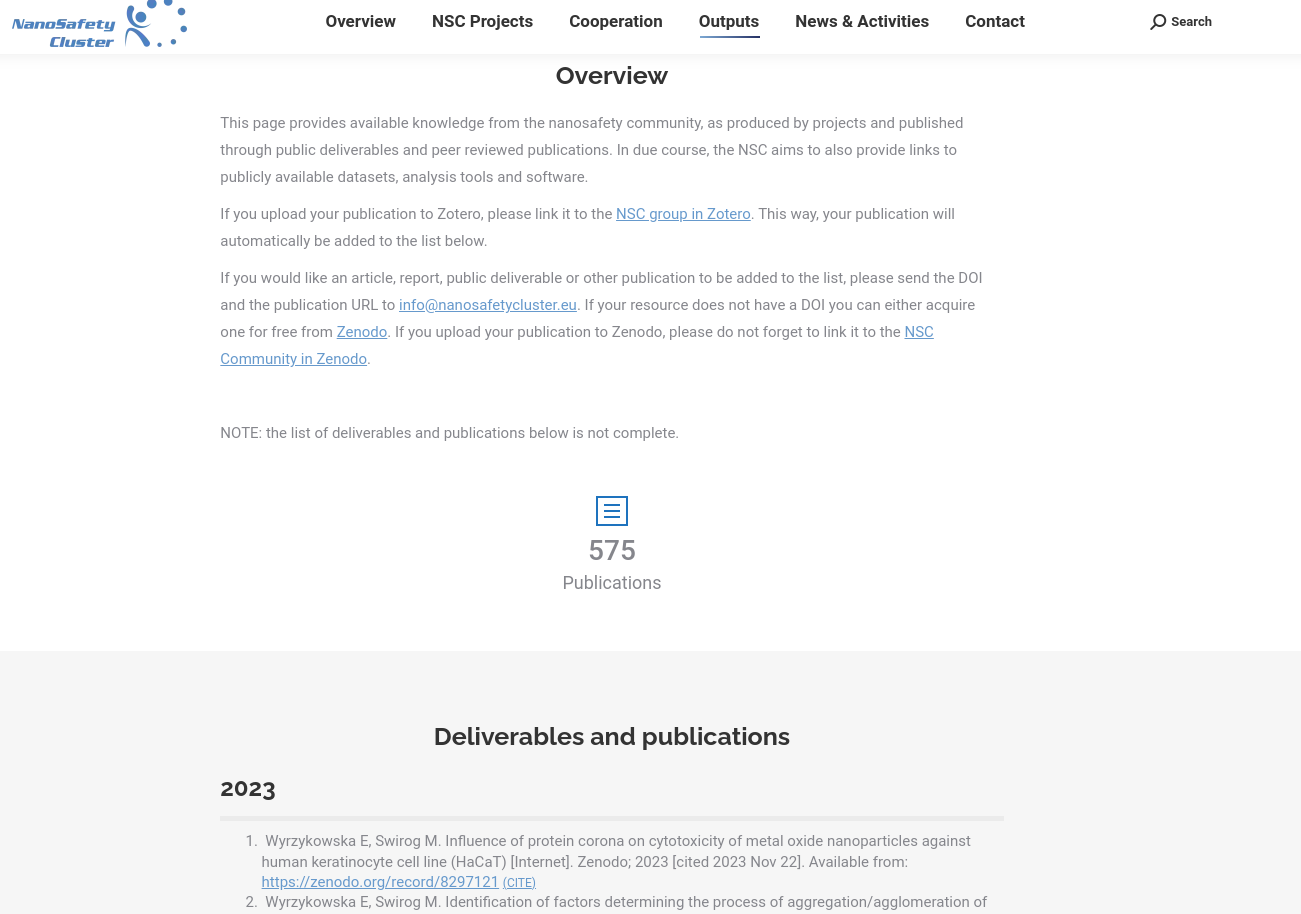Ten simple actions to make NSC Research Output more Findable
A lot has been written about the FAIR principles for making data findable, accessible, interoperable, and reusable (just search for FAIR “NanoSafety Cluster” in Google Scholar). But now we must continue to put these things into practice.
Table of contents
This document is an adaptation of an earlier published contribution to the 2024 NSC Update #01, see https://zenodo.org/records/10533126. It describes a few solutions adopted by the NSC that can be used by any NSC project partner. Here, we widen the focus from data to research output, as proposed by Houweling and Willighagen (Houweling and Willighagen, 2023). We can even push this all the way to make NSC projects themselves more FAIR, as described in this newsletter in 2018 (Willighagen et al., 2018). To me, this is important, as a lot of nanosafety knowledge is not easily captured in raw numbers. The integration of data sources to support nanosafety research was identified by several initiatives (Karcher et al., 2017).
Findable in Zenodo

To get a globally unique identifier for research output can easily be done with the digital object identifier (DOI). DOIs are routine minted by NSC projects using Figshare and Zenodo, not just for data, but also the NSC Newsletter and project deliverables. Zenodo is of particular interest here because of the integration with the EU CORDIS database and the Zenodo NSC Community. The link with the CORDIS database links the research output to the EU grant, while the second makes it easier to find output from other NSC projects.
Action 1 Get a DOI for your research output; it is by far the easiest way to make your work more FAIR.
Action 2 If your NSC project does not have a Zenodo Community, encourage your project coordinator to create one. Example communities exist for the three Nano Risk Governance projects, NanoSolveIT, NanoCommons, and SbD4Nano.
Action 3 Link your research output on Zenodo to at least the NSC Community.
Findable in the NSC Website

Findable in Zenodo - let the NSC know
The DOI makes it possible for other efforts to propagate the metadata of the research output. For example, DataCite indexes output in Figshare and Zenodo (Brase, 2009). The NanoSafety Cluster also keeps track of research output on their website (see the above screenshot). For this, it keeps a Zotero group of data, journal articles, and project deliverables, assuming they have DOIs. The content of this library is embedded as a publication list on the NSC website. The NSC collected more than 500 journal articles (the oldest from 2010), 55 datasets, and 37 project deliverables, knowing this is just a subset of the full output of the cluster.
Action 4 Therefore, we welcome submission of more DOIs. Instructions on how to send DOIs for data, articles, deliverables, etc, to the NSC cluster. They can be found at nanosafetycluster.eu/outputs/public-deliverables-publications/.
Findable based on JRC and ERM identifiers
But if we can go beyond sharing the main metadata of the output (title, authors, venue, publication date), then we realize that this is just the start: we want to find research output about a particular (type of) nanomaterial. This is more interesting for risk assessment than finding all articles by some researcher, which undoubtedly misses much relevant literature. That is, we are just starting to realize how we want to find research output (Ammar et al., 2020).
Therefore, when you get a DOI for research output, use nanomaterial identifiers clearly in the research output or even as keywords. The latter was recently done by a NanoSolveIT partner (Knigge et al., 2023). Identifiers that can be used include the identifiers for the JRC representative industrial nanomaterials (Totaro et al., 2016) and the European Registry of Materials identifier (van Rijn et al., 2022). The InChI for nanomaterials (NInChI) is still under development and may not yet be persistent (Lynch et al., 2020).
The Research Output management, FAIRness & sharing working group (formerly, WGF and WG4) has activities to propagate metadata of research output about nanomaterials. Particularly, these two projects started under the NanoCommons project: one project tracks journal articles about the JRC materials; the second tracks citable datasets with open licenses:
- Ontology IRIs for the JRC representative industrial nanomaterials (see Action 6)
- Overview of open datasets released by NanoSafety Cluster projects (see Action 7)
Both websites make use of Bioschemas standards which are supported by major search engines like Google Search. For example, by listing datasets in the overview, they automatically become visible in the Google Dataset Search.
Action 5 Use nanomaterial identifiers clearly in research output and ideally as keywords.
Action 6 If you find your research article about JRC materials missing in the JRC representative industrial nanomaterials page, register the DOI with the NSC website (see Action 4).
Action 7 If you find your open-licensed dataset missing in the Overview of open datasets, email me the DOI.
Findable via ELIXIR
Elsewhere in this NSC Updates (Willighagen, 2024) you will find an article on the ELIXIR Toxicology Community, described in more detail in a recent whitepaper (Martens et al., 2023). The next three actions are simple solutions to make other types of research (project) output more findable: training material, computational services, standards. You do not have to be a member of the Toxicology Community to take these actions.
Action 8 Training material can be registered in the ELIXIR TeSS platform, like NanoCommons did too. You can log in via the LS Identifier using your ORCID.
Action 9 Computational services can be registered with the ELIXIR bio.tools platform, and link your services to the toxicology domain.
Action 10 Read the recipes in the ELIXIR-hosted FAIR CookBook which gives many more ideas on how to make your output more FAIR (Rocca-Serra et al., 2023).
Conclusion
This article gives ten simple actions to make EU NanoSafety Cluster research output more findable using solutions adopted by the NSC (projects). Findable is a minimal step for making output more reusable (more FAIR) and at the very least supports our dissemination activities and exchange of knowledge about nanomaterial safety. For experimental nanosafety data, the sharing via community templates is coming along nicely (GRACIOUS, 2019, Kochev et al., 2020). But I wish for a future where all NSC research output is made findable, whether open-licensed or not. The EU NanoSafety Cluster helps with this, beyond just data, but needs your input, as described by the ten actions.
References
- Ammar et al., 2020: Ammar, A.; Bonaretti, S.; Winckers, L.; Quik, J.; Bakker, M.; Maier, D.; Lynch, I.; van Rijn, J.; Willighagen, E. A Semi-Automated Workflow for FAIR Maturity Indicators in the Life Sciences. Nanomaterials 2020, 10 (10), 2068. https://doi.org/10.3390/nano10102068.
- Brase, 2009: Brase, J. DataCite - A Global Registration Agency for Research Data. In 2009 Fourth International Conference on Cooperation and Promotion of Information Resources in Science and Technology; IEEE: Beijing, China, 2009; pp 257–261. https://doi.org/10.1109/COINFO.2009.66.
- GRACIOUS, 2019: European Commission. Joint Research Centre. GRACIOUS Data Logging Templates for the Environmental, Health and Safety Assessment of Nanomaterials.; Publications Office: LU, 2019.
- Houweling and Willighagen, 2023Houweling, J.; Willighagen, E. Research Output Management. Qeios 2023. https://doi.org/10.32388/ZNWI7T.
- Karcher et al., 2017: Karcher, S.; Willighagen, E. L.; Rumble, J.; Ehrhart, F.; Evelo, C. T.; Fritts, M.; Gaheen, S.; Harper, S. L.; Hoover, M. D.; Jeliazkova, N.; Lewinski, N.; Marchese Robinson, R. L.; Mills, K. C.; Mustad, A. P.; Thomas, D. G.; Tsiliki, G.; Hendren, C. O. Integration among Databases and Data Sets to Support Productive Nanotechnology: Challenges and Recommendations. NanoImpact 2017, 9, 85–101. https://doi.org/10.1016/j.impact.2017.11.002.
- Knigge and Radnik, 2023: Knigge, Xenia; Radnik, Jörg. Physico-Chemical Characterization of Sterile Fe3O4 Nanoparticles by XPS / HAXPES / SEM, 2023. https://doi.org/10.5281/ZENODO.7990302.
- Kochev et al., 2020Kochev, N.; Jeliazkova, N.; Paskaleva, V.; Tancheva, G.; Iliev, L.; Ritchie, P.; Jeliazkov, V. Your Spreadsheets Can Be FAIR: A Tool and FAIRification Workflow for the eNanoMapper Database. Nanomaterials 2020, 10 (10), 1908. https://doi.org/10.3390/nano10101908.
- Lynch et al., 2020: Lynch, I.; Afantitis, A.; Exner, T.; Himly, M.; Lobaskin, V.; Doganis, P.; Maier, D.; Sanabria, N.; Papadiamantis, A. G.; Rybinska-Fryca, A.; Gromelski, M.; Puzyn, T.; Willighagen, E.; Johnston, B. D.; Gulumian, M.; Matzke, M.; Green Etxabe, A.; Bossa, N.; Serra, A.; Liampa, I.; Harper, S.; Tämm, K.; Jensen, A. C.; Kohonen, P.; Slater, L.; Tsoumanis, A.; Greco, D.; Winkler, D. A.; Sarimveis, H.; Melagraki, G. Can an InChI for Nano Address the Need for a Simplified Representation of Complex Nanomaterials across Experimental and Nanoinformatics Studies? Nanomaterials 2020, 10 (12), 2493. https://doi.org/10.3390/nano10122493.
- Martens et al., 2023: Martens, M.; Stierum, R.; Schymanski, E. L.; Evelo, C. T.; Aalizadeh, R.; Aladjov, H.; Arturi, K.; Audouze, K.; Babica, P.; Berka, K.; Bessems, J.; Blaha, L.; Bolton, E. E.; Cases, M.; Damalas, D. Ε.; Dave, K.; Dilger, M.; Exner, T.; Geerke, D. P.; Grafström, R.; Gray, A.; Hancock, J. M.; Hollert, H.; Jeliazkova, N.; Jennen, D.; Jourdan, F.; Kahlem, P.; Klanova, J.; Kleinjans, J.; Kondic, T.; Kone, B.; Lynch, I.; Maran, U.; Martinez Cuesta, S.; Ménager, H.; Neumann, S.; Nymark, P.; Oberacher, H.; Ramirez, N.; Remy, S.; Rocca-Serra, P.; Salek, R. M.; Sallach, B.; Sansone, S.-A.; Sanz, F.; Sarimveis, H.; Sarntivijai, S.; Schulze, T.; Slobodnik, J.; Spjuth, O.; Tedds, J.; Thomaidis, N.; Weber, R. J. M.; Van Westen, G. J. P.; Wheelock, C. E.; Williams, A. J.; Witters, H.; Zdrazil, B.; Županič, A.; Willighagen, E. L. ELIXIR and Toxicology: A Community in Development. F1000Research 2023, 10, 1129. https://doi.org/10.12688/f1000research.74502.2.
- Rocca-Serra et al., 2023: Rocca-Serra, P.; Gu, W.; Ioannidis, V.; Abbassi-Daloii, T.; Capella-Gutierrez, S.; Chandramouliswaran, I.; Splendiani, A.; Burdett, T.; Giessmann, R. T.; Henderson, D.; Batista, D.; Emam, I.; Gadiya, Y.; Giovanni, L.; Willighagen, E.; Evelo, C.; Gray, A. J. G.; Gribbon, P.; Juty, N.; Welter, D.; Quast, K.; Peeters, P.; Plasterer, T.; Wood, C.; Van Der Horst, E.; Reilly, D.; Van Vlijmen, H.; Scollen, S.; Lister, A.; Thurston, M.; Granell, R.; the FAIR Cookbook Contributors; Backianathan, G.; Baier, S.; Thomsen, A. C.; Cook, M.; Courtot, M.; d’Arcy, M.; Dauth, K.; Del Piico, E. M.; Garcia, L.; Goldmann, U.; Grouès, V.; Clarke, D. J. B.; Lefloch, E.; Liyanage, I.; Papadopoulos, P.; Pommier, C.; Reynares, E.; Ronzano, F.; Delfin-Rossaro, A.; Sagatopam, V.; Sedani, A.; Sedlyarov, V.; Shilova, L.; Singh, S.; Strubel, J.; Van Bochove, K.; Warnes, Z.; Woollard, P.; Xu, F.; Zaliani, A.; Sansone, S.-A. The FAIR Cookbook - the Essential Resource for and by FAIR Doers. Sci. Data 2023, 10 (1), 292. https://doi.org/10.1038/s41597-023-02166-3.
- Totaro et al., 2016: Totaro, S.; Cotogno, G.; Rasmussen, K.; Pianella, F.; Roncaglia, M.; Olsson, H.; Riego Sintes, J. M.; Crutzen, H. P. The JRC Nanomaterials Repository: A Unique Facility Providing Representative Test Materials for nanoEHS Research. Regul. Toxicol. Pharmacol. 2016, 81, 334–340. https://doi.org/10.1016/j.yrtph.2016.08.008.
- van Rijn et al., 2022: van Rijn, J.; Afantitis, A.; Culha, M.; Dusinska, M.; Exner, T. E.; Jeliazkova, N.; Longhin, E. M.; Lynch, I.; Melagraki, G.; Nymark, P.; Papadiamantis, A. G.; Winkler, D. A.; Yilmaz, H.; Willighagen, E. European Registry of Materials: Global, Unique Identifiers for (Undisclosed) Nanomaterials. J. Cheminformatics 2022, 14 (1), 57. https://doi.org/10.1186/s13321-022-00614-7.
- Willighagen et al., 2018: Willighagen, E.; Najko Jahn; Nielsen, F. Å. The EU NanoSafety Cluster as Linked Data Visualized with Scholia. NSC Newsl. 2018. https://doi.org/10.6084/M9.FIGSHARE.6727931.
- Willighagen, 2024: Willighagen, E. The ELIXIR Toxicology Community. NSC Updat. 2024. https://doi.org/10.5281/zenodo.10551071.